When I planned the trip earlier in the year, I was told the late May week I’d booked was typically in the heart of the annual striped-bass run. I heard stories of anglers hooking a hen and when they stuck the net into the water, two bucks jumped in after her. As the old adage goes, I was to expect so many fish feeding topwater that I’d be able to walk across the river and not get my boots wet. It wasn’t unusual to put more than 100 stripers in your boat, they said.
The weather had other plans. A cold snap rolled through the area and the mercury plummeted. Clouds blocked out the sun. The chill left the stripers sluggish and lazy, hanging out in the slow current at the bottom of the river. They weren’t eating — at least not anything I was throwing at them.
Our second day on the river started out somewhat promising, as we netted two decent-sized bass in the first sixty minutes. But the next six hours evaporated without so much as a nibble. We tried changing the speed and rhythm of our retrieves, swapped streamer patterns and everything else we could think of, but the results didn’t change. Despite the sinking morale, we kept at it—other than smoking and calculus—I’m no quitter.
Luckily, I was fishing with guide Ralph Richard. With his glasses and the relaxed eloquence of his speech, he gives the impression of a college professor. So, I felt as if I was enrolled in Striped Bass 101. Given Richard’s experience, I was confident that things would eventually turn around.

Finally, our perseverance paid off. I felt a familiar tug on the sinking line, which vibrated as the fish on the other end twisted, turned, and jumped from the water. Reel, reel, reel, rest. Let the fish tire itself out. Reel, reel, reel, rest. Keep that rod tip up and the line tight. Reeeeeeeeeeeeel. Don’t let it get underneath the boat. We landed the fish and a weight was lifted.
Suddenly, it was as if a switch had flipped. On nearly every cast, we were hauling in another striper. A delivered fly wouldn’t even have time to sink before a greedy fish inhaled it. Over the next two hours, we landed more than 30 striped bass.
I love Canada, especially the New Brunswick province, which gives off a vibe reminiscent of Maine in the 1970’s. I crossed the border from the U.S. while listening to Steve Duda’s excellent River Songs audiobook and drove northeast on the lightly traveled Route 8, catching glimpses of the mighty Miramichi River through the trees.
A wide, powerful river that empties into the Atlantic Ocean, the Miramichi was once one of the preeminent spots for salmon fishing along the coast of New Brunswick. Driving through the tiny hamlets dotting the highway, passing several lodges with fading Atlantic salmon emblazoned on their signs, I noticed how salmon seemed to be a huge part of the province’s identity. Known as plamu to the local Mi’kmaq people, the region’s salmon have not only been a food staple, they have held cultural and ceremonial significance to the people of this region for more than three millennia.
Located about 20 minutes outside the town of Miramichi, the Upper Oxbow Adventures Lodge has been synonymous with salmon fishing for most of its century-long history. Paintings of Atlantics and framed salmon flies line the walls of the lodge buildings. Serge Dupuis from nearby Mocton, NB, has been returning to the Upper Oxbow for more than 15 years. He and everyone else I spoke to says salmon fishing has been on the decline for years. Change can not only happen suddenly, but also gradually over decades.
“I always came for salmon, but the guides suggested giving the striped bass a try,” Dupuis says. While fishing for stripers had been fun, “I’d much rather hook a big salmon. You have to really earn a salmon … you can catch a striped bass with practically every cast sometimes.”

During a previous visit to Upper Oxbow, I spent a fruitless day fly fishing for salmon with guide Alex Swartman. Swartman told me years ago he would catch multiple salmon each time out, then maybe one or two, then one every other time, then one or two a season. Dupuis also confessed he only catches one or two salmon a year these days.
Debbie Norton, who co-owns the lodge with her pleasant, hard-working husband Dale, is a pint-sized domino, radiating positive energy like a joy-filled Chernobyl. Their son Bobby, who looks as if he just burst out of the Brawny paper towel packaging, guides and also helps run the lodge. The three of them are in constant movement; if a problem arises at the lodge, no matter how big or small, it’s resolved before the words have fully left the guest’s mouth.
Norton’s family has owned this land for more than two centuries, serving as a hunting and fishing lodge for the last hundred, so there are few people better to ask about the area’s salmon history. Both salmon and striped bass co-existed for decades, but that balance has changed significantly over the years.
According to recent and historical estimates, more than 185,000 adult Atlantic salmon returned to the Miramichi River in 1992. That number dropped to an estimated 5,315 adult returns in 2024. By contrast, the number of striped bass in the river likely exceeds more than 350,000. It’s not looking good for salmon on the Miramichi.

Experts and locals alike have theorized how and why the salmon began to decline. Warming water temperatures due to climate change was the first domino to fall; salmon need cold water. As the salmon numbers started to slide, the striped bass numbers increased — approximately 800 percent from 1994 to 2022. The aggressive striped bass preyed on the salmon smolt, further decimating the salmon population. The cycle continues today, and the outlook for salmon continues to get worse.
According to studies, warming sea temperatures are likely to lead to an even larger boom in the population of striped bass in the Miramichi and surrounding waterways. That may strike the final deathknell for salmon and other species like gaspereau (alewife).
The New Brunswick Department of Fisheries and Oceans (DFO) cites declining salmon numbers throughout eastern Canada but refuses to acknowledge the role that striped bass play in the precipitous drop in the Miramichi, meaning they do not currently support reducing the striped bass population to levels that might level the playing field. The DFO told CTV news that the northwest Miramichi River is the “only known and successful spawning ground” for the striped bass in the southern Gulf of St. Lawrence.
“DFO cannot commit to a cautionary zone and then abandon it when pressure builds,” the DFO statement read. “Sustainable fisheries are built on long-term planning, consistent data collection, and adherence to precautionary principles. This is not the time to deviate from that foundation.”
Striped bass may currently dominate the Miramichi, but Norton and her comrades believe the salmon can still make a comeback. In April, the North Shore Mi’kmaq Tribal Council proposed a five-year, $38 million plan to strengthen the salmon population by improving salmon habitat and water quality, better managing the striped bass population, reducing net fishing bycatch, enhancing cold water habitat, and increasing salmon stocking. Experts say striper numbers can be reduced to 100,000 in the Miramichi, without harm to the overall population health. Exact details about the salmon stocking wasn’t detailed in the report, but Norton says the number would be substantial throughout the 217-km long Miramichi and include both young and adult salmon. As of the initial writing of this article, neither the federal or provincial governments have officially weighed in on the proposal.
Although, according to fly fisher Patrick Williamson, Upper Oxbow adventures “has the potential to be the best striped bass lodge in the world” given the fish numbers and the lodge’s easy accessibility, Norton and her guests would love to see some parity between the two species. Dupuis, for one, is doing his part.
“Whenever I fish for stripers, I take my limit,” Dupuis says. “There needs to be a balance between salmon and bass.”
“Both species are wonderful examples of nature,” Norton says. “I’m optimistic that we can restore the equilibrium and have two healthy populations for us to enjoy.”





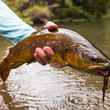
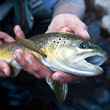
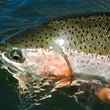
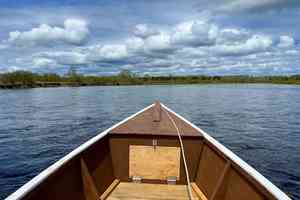
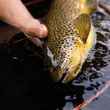





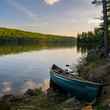
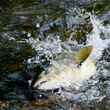

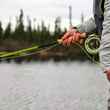

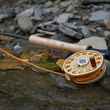


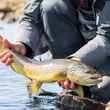
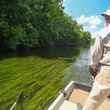

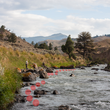
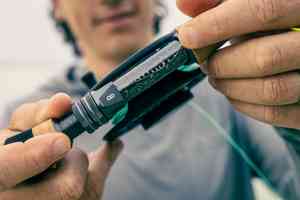
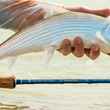
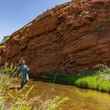


Comments